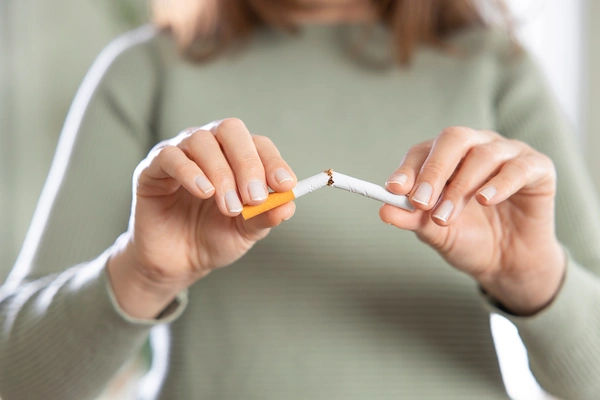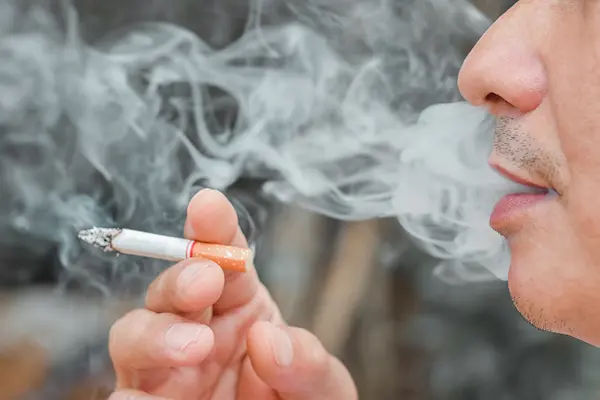Your Path to a Healthier Life: A Compassionate Guide to Quitting Tobacco
Know about quitting tobacco, effects of tobacco on health, planning, procedure to quit and withdrawal symptoms of tobacco.

Written by Dr. J T Hema Pratima
Reviewed by Dr. Dhankecha Mayank Dineshbhai MBBS
Last updated on 6th Oct, 2025

Introduction
Every journey begins with a single step. If you're considering a path to a healthier life free from tobacco, you've already taken the most important one: the decision to explore change. Quitting tobacco is one of the most significant actions you can take for your well-being, but it's often fraught with challenges and uncertainty. This guide is designed to be your compassionate companion on that path, offering evidence-based strategies, realistic expectations, and the encouragement needed to succeed. Whether you smoke cigarettes, use chewing tobacco, or rely on vaping, this article will provide a clear map to a brighter, healthier future.
Understanding Your Journey: Why This Path Matters
Embarking on the path to a healthier life requires a clear understanding of what you're moving away from and what you're moving toward. It’s not just about giving something up; it’s about gaining everything back.
Consult Top Specialists for Personalised Tips
The Immediate and Long-Term Toll of Tobacco
Tobacco use, in any form, delivers a powerful one-two punch to your health. Immediately, it increases your heart rate and blood pressure, while carbon monoxide from smoke hijacks oxygen in your bloodstream. Long-term, the damage accumulates silently but surely. It's a primary cause of various cancers (lung, throat, mouth, and more), chronic obstructive pulmonary disease (COPD), heart disease, stroke, and a weakened immune system. Understanding these risks isn't meant to scare you, but to empower you with the knowledge of what you can prevent.
Beyond Physical Health: The Financial and Social Impact
The cost of tobacco isn't just measured in health risks. Financially, the habit drains your resources. A pack-a-day smoker can spend thousands of dollars a year—money that could be invested in experiences, savings, or personal goals. Socially, tobacco can isolate you. The need to step away for a smoke, the smell on clothes and breath, and the growing social stigma can affect personal and professional relationships. Choosing a healthier path reclaims not just your health, but also your finances and social freedom.
Charting Your Course: Preparing to Quit Successfully
A successful journey requires preparation. Rushing in without a plan is a common reason for relapse. Thoughtful preparation lays the foundation for lasting success.
Identify Your "Why": The Key to Motivation
Your reason for quitting must be powerful and personal. Is it to see your children grow up? To breathe easier during physical activity? To save money for a vacation? To regain a sense of control? Write this "why" down and keep it somewhere visible. When cravings hit, this personal mission statement will be your anchor. This is a core strategy for effective smoking cessation.
Choosing Your Quit Date: Setting Yourself Up for Success
Don't just quit on a whim. Set a date within the next two weeks. This gives you enough time to prepare mentally, but not so long that you lose motivation. Avoid choosing a date during a period of high stress. Some people prefer a symbolic date, like a birthday or anniversary, while others choose a calm Monday to start the week fresh. Inform your friends and family about this date to build accountability.
Navigating the First Steps: Quitting Methods Explained
There is no single "right" way to quit. The best method is the one that works for you. Here’s a look at the most common approaches to help you decide.
Nicotine Replacement Therapy (NRT): A Stepping Stone
NRT helps manage nicotine withdrawal symptoms by providing a controlled, safer dose of nicotine without the other harmful chemicals in tobacco. Options include patches (for steady release), gum, lozenges, inhalers, and nasal sprays (for quick craving relief). Using a combination (like a patch plus gum) is often more effective than a single product. If you are unsure which NRT is right for you, consulting a doctor online with Apollo24|7 can provide personalised advice.
Prescription Medications: When to Seek Medical Help
For some, prescription drugs like Varenicline (Chantix) or Bupropion (Zyban) can be highly effective. They work by interacting with brain chemistry to reduce cravings and lessen the pleasure derived from smoking. These require a prescription and should be discussed with a healthcare professional to assess suitability and potential side effects.
Weathering the Storm: Managing Nicotine Withdrawal
Withdrawal is your body’s reaction to being without nicotine. It can be uncomfortable, but it is temporary and a sign that your body is healing.
Common Withdrawal Symptoms and What They Mean
Symptoms can include irritability, anxiety, difficulty concentrating, increased appetite, and strong cravings for tobacco. It's crucial to remember that these peaks of intensity are short-lived, usually lasting only 5-10 minutes. Acknowledging them without fear is the first step to moving through them. The first week is typically the most challenging, with symptoms gradually subsiding over 2-4 weeks.
Practical Craving-Busting Techniques
When a craving strikes, have a toolkit ready:
Delay: Tell yourself you’ll wait 10 minutes. The craving often passes.
Distract: Chew gum, drink a glass of water, or go for a brisk walk.
Deep Breathing: Inhale slowly for a count of four, hold for four, exhale for four. This mimics the calming effect of smoking.
Use a Substitute: Keep crunchy vegetables, sunflower seeds, or a stress ball handy to keep your hands and mouth busy.
When to Seek Professional Guidance
While many succeed on their own, there's no shame in seeking help. If you've tried to quit multiple times without success, if you experience severe depression or anxiety, or if you simply want a structured plan, professional support can make all the difference. A doctor can help you create a tailored cessation plan, including prescription options. If your journey feels overwhelming, consider booking a consultation with a specialist through Apollo24|7.
Conclusion
The path to a healthier life without tobacco is undoubtedly challenging, but it is also one of the most rewarding journeys you will ever undertake. Every craving resisted is a victory. Every day without tobacco is a step toward a future with more energy, better health, and greater freedom. You will rediscover tastes and smells, breathe more deeply, and gain a profound sense of self-efficacy. There may be setbacks, but they are not failures; they are learning experiences. Use the strategies in this guide, lean on your support system, and be kind to yourself throughout the process. Your healthier life is not a distant dream; it's a destination that gets closer with every positive choice you make. Start your path today.
Consult Top Specialists for Personalised Tips

Dr. Rajib Ghose
General Physician/ Internal Medicine Specialist
25 Years • MBBS
East Midnapore
VIVEKANANDA SEBA SADAN, East Midnapore

Dr. Ashita Kuruvilla
General Physician/ Internal Medicine Specialist
7 Years • MBBS
East Midnapore
VIVEKANANDA SEBA SADAN, East Midnapore

Dr. Tapabrata Ray
General Physician/ Internal Medicine Specialist
4 Years • MBBS,DGM,CPMeC,ACMDC
Kolkata
MCR SUPER SPECIALITY POLY CLINIC & PATHOLOGY, Kolkata

Dr. Pankaj Tripathi
General Practitioner
20 Years • MBBS, MD Pathology
Lucknow
Best Diabetologist Clinic, Lucknow

Dr. Rupam Chowdhury
Orthopaedician
10 Years • MBBS, DNB (Ortho.)
Kolkata
MCR SUPER SPECIALITY POLY CLINIC & PATHOLOGY, Kolkata
More articles from Smoking Cessation
Frequently Asked Questions
What is the most effective way to quit tobacco?
There is no single 'most effective' way for everyone. Success depends on the individual. Combining methods—such as using Nicotine Replacement Therapy (NRT) alongside behavioural support or a quit-smoking app—often yields the highest success rates. Finding what works for your lifestyle is key.
How long do nicotine cravings last after quitting?
Intense cravings are typically short, lasting about 5 to 10 minutes. The frequency of these cravings will be highest in the first few days and weeks after quitting. For most people, the physical symptoms of nicotine withdrawal subside within 2 to 4 weeks, though psychological triggers may persist longer.
Will I gain weight after I quit?
Some people do experience weight gain, usually 5-10 pounds, due to an increased appetite and a return of taste buds. However, this can be managed by staying active, drinking plenty of water, and having healthy snacks like fruits and vegetables on hand. The health benefits of quitting far outweigh the risks of minor weight gain.
Is vaping a safe alternative to help me quit smoking?
While vaping is generally considered less harmful than traditional cigarettes because it doesn't involve combustion, it is not risk-free. The long-term health effects are still unknown, and e-cigarettes still contain nicotine, which is addictive. The U.S. FDA has not approved vaping as a cessation method. Proven methods like NRT and prescription medications are safer and more regulated options.
What should I do if I relapse and use tobacco again?
Don't view a lapse as a total failure. It's a common part of the quitting process for many people. The important thing is not to let one slip become a full relapse. Identify what triggered the lapse (stress, alcohol, social situation), learn from it, and recommit to your quit plan immediately. Remember your 'why' and get back on track.



_0.webp)
